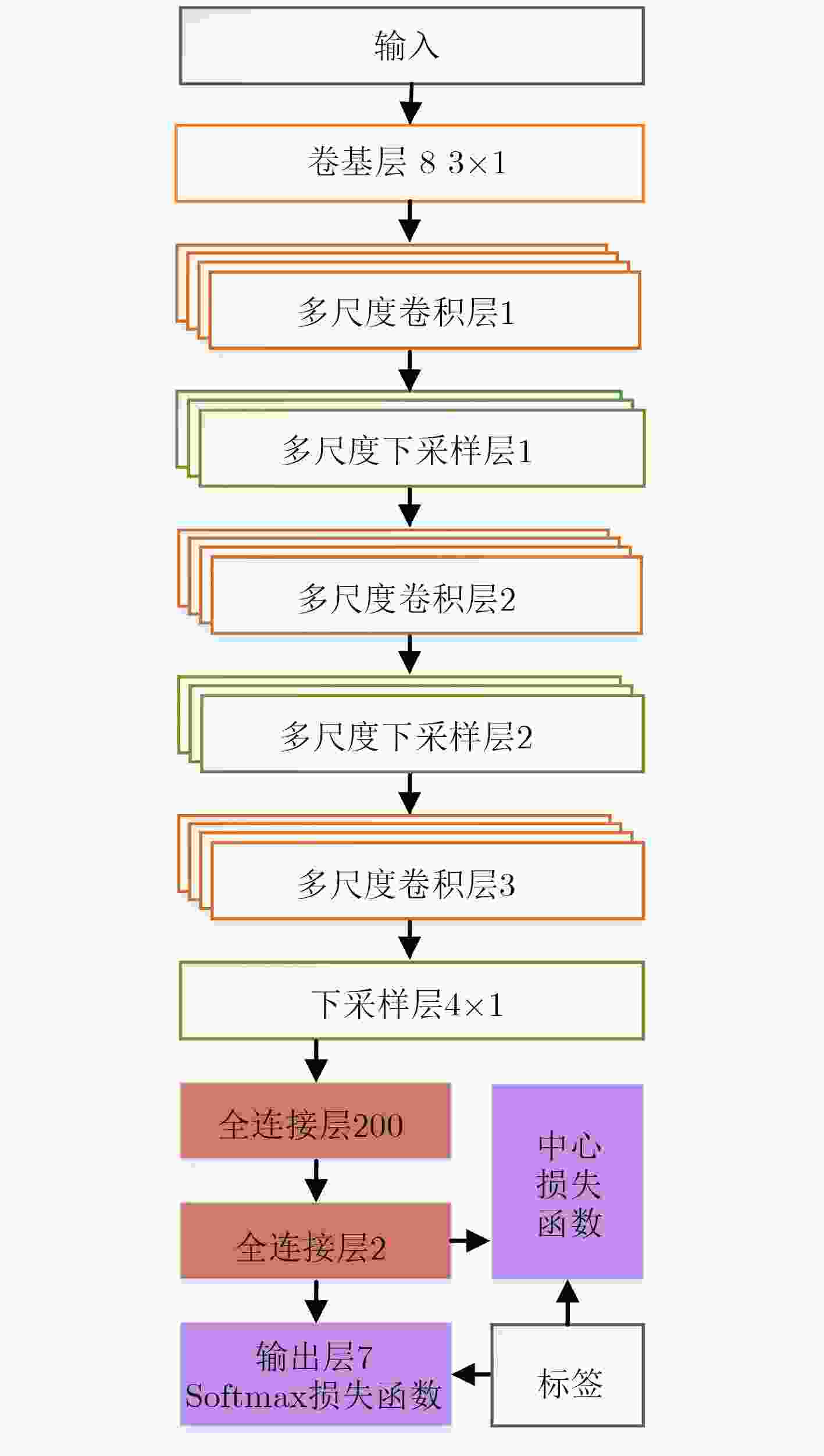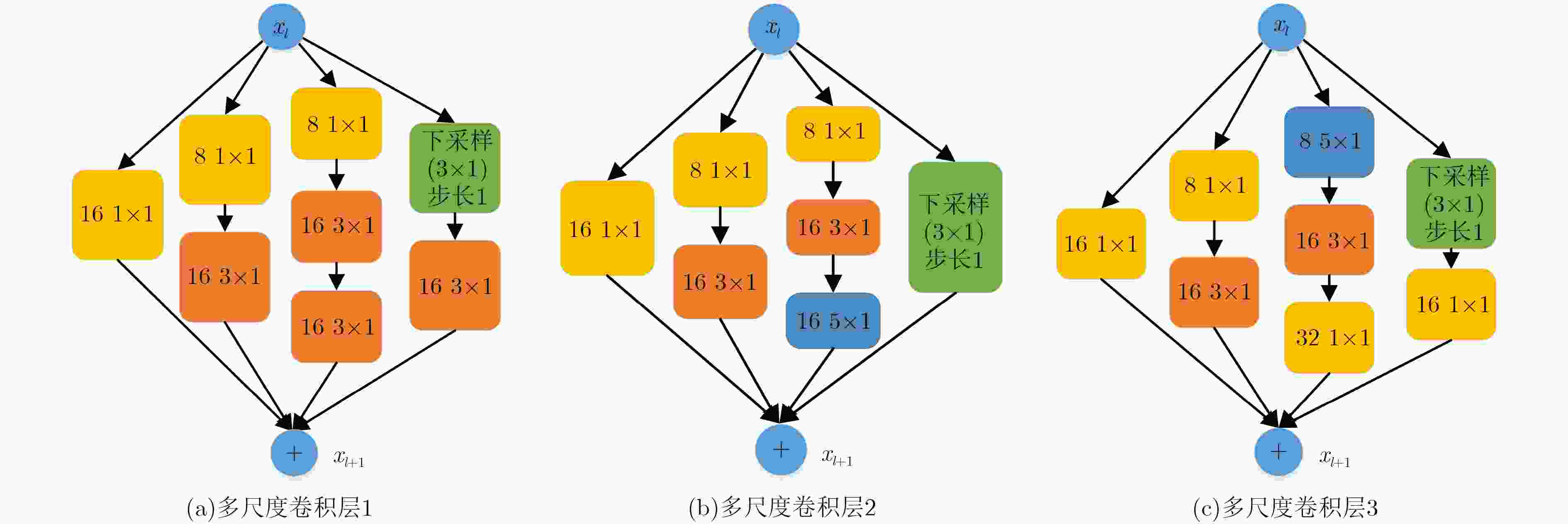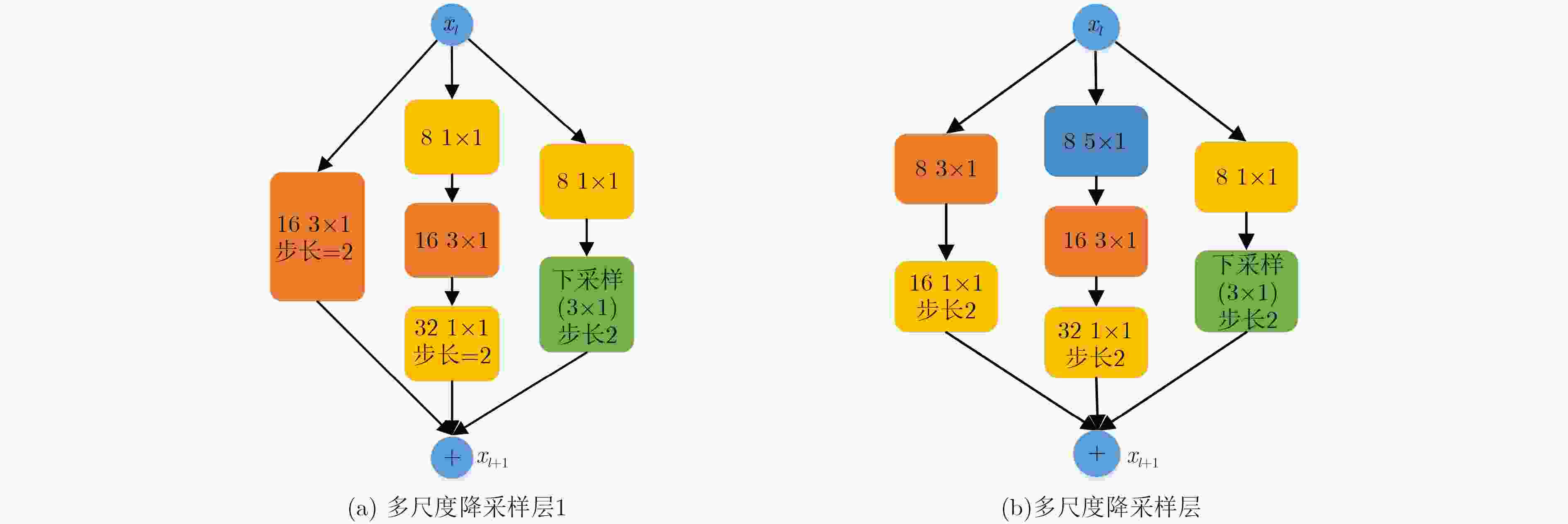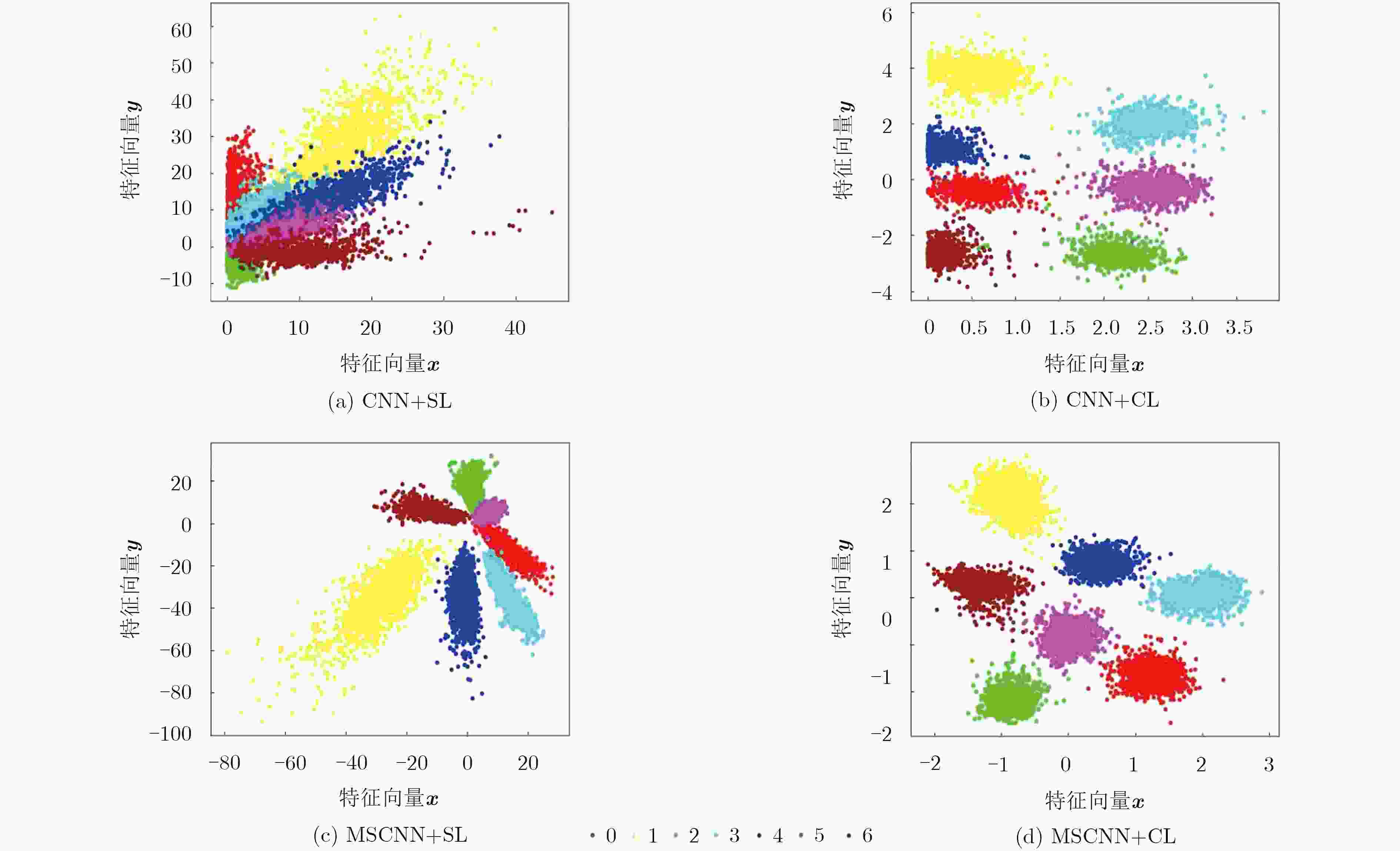Radar HRRP Target Recognition Based on Deep Multi-Scale 1D Convolutional Neural Network
-
摘要: 为满足雷达舰船目标识别的高实时性和高泛化性的需求,该文提出了一种基于深度多尺度1维卷积神经网络的目标高分辨1维距离像(HRRP)识别方法。针对高分辨1维距离像特征提取难的问题,所提方法通过共享卷积核的权值,使用多尺度的卷积核提取不同精细度的特征,并构造中心损失函数来提高特征的分辨能力。实验结果表明,该模型可以显著提高目标在非理想条件下的识别正确率,克服目标姿态角敏感性问题,具有良好的鲁棒性和泛化性。Abstract: In order to meet the demand for high real-time and high generalization performance of radar recognition, a radar High Resolution Range Profile (HRRP) recognition method based on deep multi-scale one dimension convolutional neural network is proposed. The multi-scale convolutional layer that can represent the complex features of HRRP is designed based on two features of the convolution kernels which are weight sharing and extraction of different fineness features from different scales, respectively. At last, the center loss function is used to improve the separability of features. Experimental results show that the model can greatly improve the accuracy of the target recognition under non-ideal conditions and solve the problem of the target aspect sensitivity, which also has good robustness and generalization performance.
-
表 1 所提模型中主要的特征提取层的参数个数
卷积层 多尺度卷积层1 多尺度下采样层1 多尺度卷积层2 多尺度下采样层2 多尺度卷积层3 全连接层 合计 24 1552 4480 6016 4480 5760 2560 24872 表 2 CNN中主要的特征提取层的参数个数
卷积层32, 5×1 卷积层32, 5×1 卷积层64, 3×1 卷积层64, 3×1 卷积层128, 1×1 卷积层128, 1×1 全连接层2 合计 160 5120 6144 12288 8192 16384 2048 50336 表 3 自编码模型中主要的特征提取层的参数个数
隐藏层1, 600 隐藏层2, 300 隐藏层3, 50 合计 307200 180000 15000 502200 表 4 7种舰船目标的结构参数(m)
舰船编号 舰长 舰宽 吃水深度 1 182.8 24.1 8.1 2 172.8 16.8 6.5 3 153.8 20.4 6.3 4 135.0 16.8 4.5 5 121.0 17.6 4.3 6 102.2 16.5 4.2 7 89.3 12.1 4.0 表 5 不同模型深度条件下的识别正确率(%)
模型 识别正确率 本文模型 97.67 模型a 89.23 模型b 82.41 模型c 75.25 表 6 所提模型与对比模型在不同信噪比条件下的目标识别正确率(%)
模型名称 SNR (dB) 5 10 15 本文模型 95.12 97.67 98.90 CNN+CL 93.88 95.89 97.56 SDAE+MLP 90.58 92.15 93.22 SAE+ELM 90.94 92.63 94.05 表 7 所提模型与对比模型在数据集B下的目标识别正确率(%)
本文模型 CNN+CL SDAE+MLP SAE+ELM 94.83 93.51 90.93 91.27 -
DU Lan, WANG Penghui, LIU Hongwei, et al. Bayesian spatiotemporal multitask learning for radar HRRP target recognition[J]. IEEE Transactions on Signal Processing, 2011, 59(7): 3182–3196. doi: 10.1109/TSP.2011.2141664 WANG Yu, ZHANG Liang, WANG Suixue, et al. Radar HRRP target recognition using scattering centers fuzzy matching[C]. Proceedings of 2016 CIE International Conference on Radar, Guangzhou, China, 2016: 1–5. doi: 10.1109/RADAR.2016.8059195. PEI Bingnan and BAO Zheng. Multi-aspect radar target recognition method based on scattering centers and HMMs classifiers[J]. IEEE Transactions on Aerospace and Electronic Systems, 2005, 41(3): 1067–1074. doi: 10.1109/TAES.2005.1541451 JIANG Yue, HAN Yubing, and SHENG Weixing. Target recognition of radar HRRP using manifold learning with feature weighting[C]. Proceedings of 2016 IEEE International Workshop on Electromagnetics: Applications and Student Innovation Competition, Nanjing, China, 2016: 1–3. doi: 10.1109/iWEM.2016.7505053. ZHOU Daiying. Radar target HRRP recognition based on reconstructive and discriminative dictionary learning[J]. Signal Processing, 2016, 126: 52–64. doi: 10.1016/j.sigpro.2015.12.006 冯博, 陈渤, 王鹏辉, 等. 利用稳健字典学习的雷达高分辨距离像目标识别算法[J]. 电子与信息学报, 2015, 37(6): 1457–1462. doi: 10.11999/JEIT141227FENG Bo, CHEN Bo, WANG Penghui, et al. Radar high resolution range profile target recognition algorithm via stable dictionary learning[J]. Journal of Electronics &Information Technology, 2015, 37(6): 1457–1462. doi: 10.11999/JEIT141227 李龙, 刘峥. 基于核主分量相关判别分析特征提取方法的目标HRRP识别[J]. 电子与信息学报, 2018, 40(1): 173–180. doi: 10.11999/JEIT170329LI Long and LIU Zheng. Kernel principal component correlation and discrimination analysis feature extraction method for target HRRP recognition[J]. Journal of Electronics &Information Technology, 2018, 40(1): 173–180. doi: 10.11999/JEIT170329 GUO Yu, XIAO Huaitie, KAN Yingzhi, et al. Learning using privileged information for HRRP-based radar target recognition[J]. IET Signal Processing, 2018, 12(2): 188–197. doi: 10.1049/iet-spr.2016.0625 PAN Mian, JIANG Jie, KONG Qingpeng, et al. Radar HRRP target recognition based on T-SNE segmentation and discriminant deep belief network[J]. IEEE Geoscience and Remote Sensing Letters, 2017, 14(9): 1609–1613. doi: 10.1109/LGRS.2017.2726098 PAN Mian, JIANG Jie, LI Zhu, et al. Radar HRRP recognition based on discriminant deep autoencoders with small training data size[J]. Electronics Letters, 2016, 52(20): 1725–1727. doi: 10.1049/el.2016.3060 FENG Bo, CHEN Bo, and LIU Hongwei. Radar HRRP target recognition with deep networks[J]. Pattern Recognition, 2017, 61: 379–393. doi: 10.1016/j.patcog.2016.08.012 YAN Huaqing, ZHANG Zenghui, XIONG Gang, et al. Radar HRRP recognition based on sparse denoising autoencoder and multi-layer perceptron deep model[C]. Proceedings of the 4th International Conference on Ubiquitous Positioning, Indoor Navigation and Location Based Services, Shanghai, China, 2016: 283–288. doi: 10.1109/UPINLBS.2016.7809986. ZHAI Ying, CHEN Bo, ZHANG Hao, et al. Robust variational auto-encoder for radar HRRP target recognition[C]. Proceedings of the 7th International Conference on Intelligent Science and Big Data Engineering, Dalian, China, 2017: 356–367. doi: 10.1007/978-3-319-67777-4_31. ZHAO Feixiang, LIU Yongxiang, HUO Kai, et al. Radar HRRP target recognition based on stacked autoencoder and extreme learning machine[J]. Sensors, 2018, 18(1): 173. doi: 10.3390/s18010173 LUNDéN J and KOIVUNEN V. Deep learning for HRRP-based target recognition in multistatic radar systems[C]. Proceedings of 2016 IEEE Radar Conference, Philadelphia, USA, 2016: 1–6. doi: 10.1109/RADAR.2016.7485271. BENGIO Y I, GOODFELLOW I, and COURVILLE A. Deep Learning[M]. Cambridge, USA: MIT Press, 2016: 276–324. SZEGEDY C, LIU Wei, JIA Yangqing, et al. Going deeper with convolutions[C]. Proceedings of 2015 IEEE Conference on Computer Vision and Pattern Recognition, Boston, USA, 2015: 1–9. doi: 10.1109/CVPR.2015.7298594. SZEGEDY C, IOFFE S, VANHOUCKE V, et al. Inception-v4, Inception-ResNet and the impact of residual connections on learning[C]. Proceedings of the 31st AAAI Conference on Artificial Intelligence, San Francisco, USA, 2017: 4278–4284. WEN Yandong, ZHANG Kaipeng, LI Zhifeng, et al. A discriminative feature learning approach for deep face recognition[C]. Proceedings of the 14th European Conference on Computer Vision, Amsterdam, Netherlands, 2016: 499–515. doi: 10.1007/978-3-319-46478-7_31. -






 下载:
下载:





 下载:
下载:
